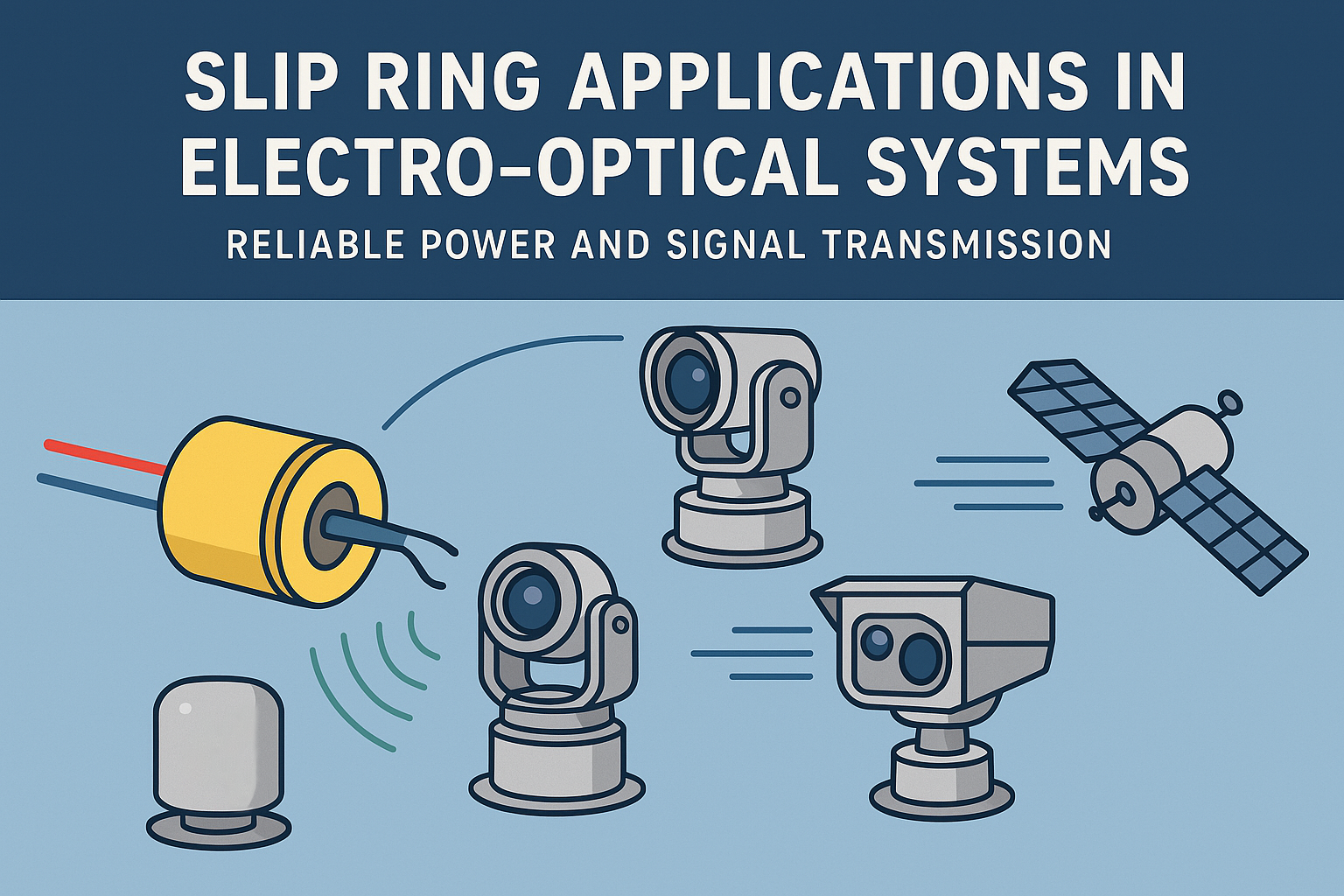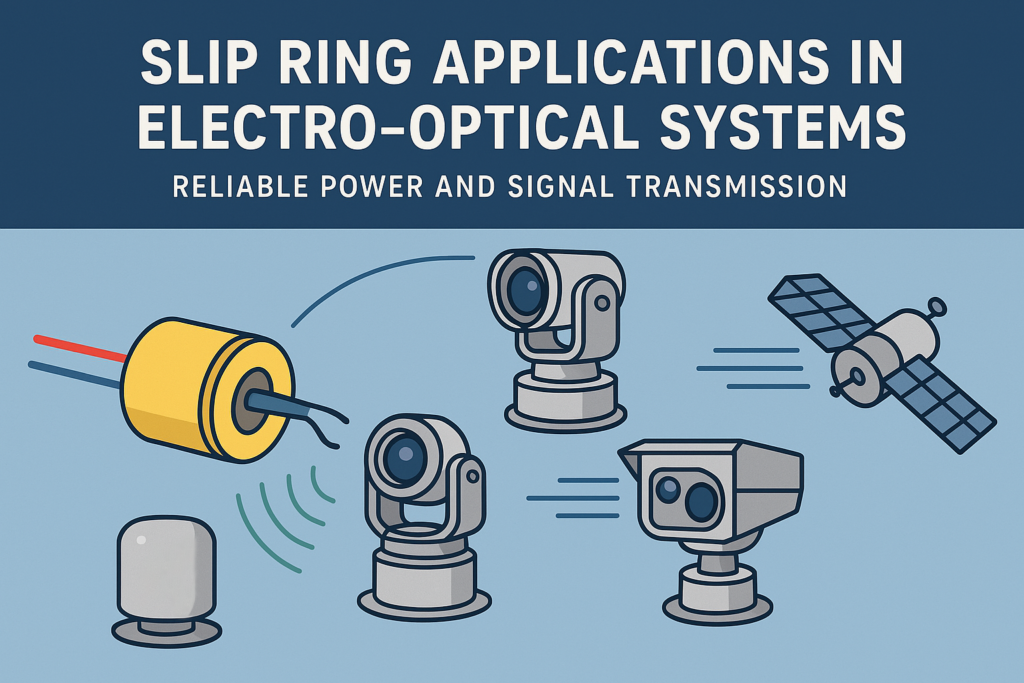Slip Ring Applications in Electro-Optical Systems: Reliable Power and Signal Transmission
 Slip Ring for Electro-Optical Systems: Reliable Power and Signal Transmission
Slip Ring for Electro-Optical Systems: Reliable Power and Signal Transmission
In today’s defense and security landscape, slip ring for electro-optical systems is an essential component that ensures uninterrupted signal and power transmission. Electro-optical (EO) platforms are critical in surveillance, target acquisition, and tracking operations. These systems are typically mounted on rotating bases, requiring a reliable interface between stationary and rotating parts—this is where slip ring technology comes in.
 Where Are Electro-Optical Systems Used?
Where Are Electro-Optical Systems Used?
-
Armored vehicles: Turret-mounted imaging and laser systems
-
UAVs and drones: Gimballed EO/IR payloads
-
Border security: Fixed surveillance towers
-
Naval platforms: 360° observation and tracking systems
Such systems require continuous transmission of power, video, and control signals through rotating mechanisms—a task ideally suited for slip rings in electro-optical systems.
 What Role Do Slip Rings Play in Electro-Optical Systems?
What Role Do Slip Rings Play in Electro-Optical Systems?
Slip rings provide seamless transfer of:
-
DC/AC power
-
HD video signals (e.g., HD-SDI)
-
Control data (RS485, CAN, Ethernet)
-
Fiber optic data (optional)
These enable 360° rotation without data loss or cable twisting—ensuring full functionality of the electro-optical payload.
 Key Requirements for Electro-Optical Slip Rings
Key Requirements for Electro-Optical Slip Rings
EO slip rings must meet stringent requirements:
-
Low electrical noise
-
High ingress protection (IP65 or higher)
-
EMC/EMI shielding
-
Lightweight and compact design (SWaP optimization)
-
Integration with fiber optic or RF rotary joints
These specifications ensure reliability in harsh military and security environments.
 Application-Specific Slip Ring Customization
Application-Specific Slip Ring Customization
Electro-optical systems often demand tailored slip ring solutions, such as:
-
2 power + 4 HD video + 2 Ethernet + fiber optic
-
MIL-DTL-38999 connector support
-
MIL-STD-810 compliance
Custom slip rings enhance performance, durability, and system integration in electro-optical applications.
 Future Trends in Slip Rings for EO Systems
Future Trends in Slip Rings for EO Systems
Innovation in slip ring for electro-optical systems is driven by the need for:
-
Modular architectures
-
High-speed data transmission
-
Real-time diagnostics and monitoring
These features will support next-gen EO platforms with improved efficiency and reliability.
 Conclusion
Conclusion
Slip ring for electro-optical systems is not just a mechanical component—it’s a mission-critical enabler of 360° operation, signal clarity, and uninterrupted power. As EO technology evolves, slip ring solutions must advance too—smarter, smaller, and stronger than ever before.
 Where Are Electro-Optical Systems Used?
Where Are Electro-Optical Systems Used?
Armored vehicles: turret-mounted imaging and laser systems
UAVs and drones: gimballed EO/IR payloads
Border security and fixed surveillance towers
Naval platforms: 360° observation and tracking systems
Such systems require uninterrupted transmission of power, data, and video through rotating interfaces.
 What Role Do Slip Rings Play?
What Role Do Slip Rings Play?
Slip rings enable the seamless transfer of:
DC/AC power
HD video signals (e.g., HD-SDI)
Control signals (RS485, CAN, Ethernet)
Fiber optic data (optional)
between the fixed base and the rotating EO unit. This ensures full 360° rotation without any signal loss or cable twist.
 Key Requirements for EO Slip Rings
Key Requirements for EO Slip Rings
Slip rings designed for electro-optical systems must meet strict technical standards, such as:
Low electrical noise transmission
High ingress protection (IP65 or higher)
EMC/EMI shielding
Compact and lightweight form factor (SWaP optimization)
Integration of fiber optic or RF rotary joints
These features ensure stability in demanding field environments.
 Application-Specific Customization
Application-Specific Customization
EO platforms often require custom-designed slip ring assemblies, for example:
2 power channels + 4 HD video channels + 2 Ethernet channels + fiber optic line
MIL-DTL-38999 connector integration
Compliance with MIL-STD-810 for shock, vibration, and temperature
Custom solutions improve system integration and operational reliability.
 Looking Ahead: Smaller, Smarter, and Faster
Looking Ahead: Smaller, Smarter, and Faster
The future of electro-optical systems demands more performance in less space. This is driving slip ring innovations in areas like:
Modular slip ring architectures
High-frequency data transfer
Embedded diagnostics and condition monitoring
Such advancements will enable next-generation EO systems to operate with greater precision and reliability.
 Conclusion
Conclusion
In electro-optical platforms, slip rings are critical enablers of uninterrupted rotation, consistent power delivery, and noise-free data transmission. As EO technology evolves, so must the slip ring solutions that support it — with higher performance, smarter features, and extreme reliability.


